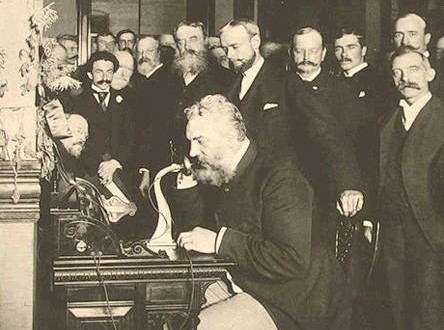Alexander Graham Bell was able to invent the telephone after Watson tweaked a reed that transmitted sounds to the next room
-
Winter 2010
Volume59Issue4
On a hot day in June 1875, 28-year-old Alexander Graham Bell and his assistant, Thomas Watson, were toiling in adjacent workshops at 109 Court Street in Boston. Under sloped attic walls of rough-sawn wood, the two men hunched over benches covered with curled wires and jar-shaped batteries filled with acid. A few years before, an inventor named Joseph Stearns had made a fortune selling Western Union a device capable of sending two telegraphs simultaneously over one wire. Bell hoped to leapfrog that invention with a telegraph using different tones to transmit many messages at the same time.
After Watson plucked a reed to test the transmitter, Bell was surprised to hear a faint sound reproduced on the receiving device in his room. A former concert pianist, he instantly recognized the miracle that had occurred: the sound waves of a complex musical note had induced a current in the wire and reconstituted in the next room.

The idea of creating “an instrument by which the human voice might be telegraphed” first came to Bell the summer before, while he had been visiting his parents in Brantford, Ontario. While many others had conjured the notion of talking by wire, Bell had a theory that would ultimately make the idea work: “The vibrations of a permanent magnet will induce a vibrating current of electricity in the coils of an electromagnet,” he wrote in a letter to his parents on November 23, 1874. “Please keep this paper as a record of the conception of the idea.” Unlike the make-or-break contacts used in a telegraph, the telephone required a continuous current that could carry both tone and amplitude.
At that moment in Boston the following summer, Bell realized the reed had transmitted a musical note by means of an “induced” magnetic current. He quickly sketched a device with a membrane stretched over a U-shaped electromagnet, and Watson crafted the idea into a working model. When this “gallows” telephone was tested the following month, Bell recalled that “Mr. Watson came rushing down the stairs in a state of great excitement, saying, ‘Why, Mr. Bell, I heard your voice very distinctly, and could almost understand what you said.’” Although it was hardly a practicable invention yet, the two young men immediately understood the device’s potential.
Bell also knew he was in a tight race with Chicago inventor Elisha Gray to invent the multiple telegraph and possibly this new telephone idea. Although not a trained electrician, Bell had some advantages over Gray. A teacher of deaf children during the day and a tinkerer by night, he had learned a great deal about the physics of sound, the mechanisms of speech, and the physiology of the human ear—practical knowledge not possessed by most electrical engineers. He had even conducted experiments with a straw attached to the ear of a dead man, transmitting sound through the bone to inscribe waves on carbon-covered glass (the precursor of the phonograph, if he had chosen to pursue that line of investigation, as Edison later would).
The fellow boarders in Bell’s Boston rooming house thought the professor crazy with his notion of talking over wires, but throughout the fall and early winter he and Watson struggled to perfect the telephone. They continued to transmit “vocal sounds” but not intelligible speech. On February 14, 1876, Bell’s attorney filed for a U.S. patent. On that same day, Gray submitted a caveat (stating an intention to invent) for a telephone.
While much has been made of the coincidence, Bell’s prior conception and documentation of a year and a half of work would win the day. The Patent Office granted him Patent No. 174,465 for the “electric speaking telephone” on March 7, and three days later the device finally “spoke” with the famous uttered words, “Mr. Watson, come here, I want to see you.” It was the most valuable single patent ever issued, opening a new age in information that would transform society with the speed and ease of communicating everything from business dealings to grocery purchases.
The growth of the tiny Bell company would not be easy. Western Union, one of the wealthiest corporations in America at the time, was soon selling thousands of telephones and had to be sued for infringement. David beat Goliath in that case, and Bell would win another 600 lawsuits over the telephone. But copper wire was prohibitively expensive, and, after shares were sold to raise money, Boston capitalists took over the company. While on a long honeymoon in England, Bell was laid off as the company’s chief electrician, the first person to be downsized by AT&T. But he would have a long and productive life, financed by selling his shares, and go on to many other inventions.
—Edwin S. Grosvenor is the Editor-in-Chief of American Heritage Magazine.

